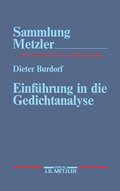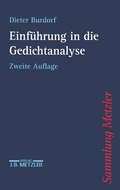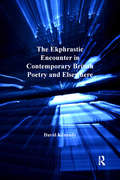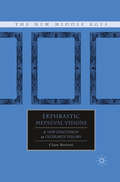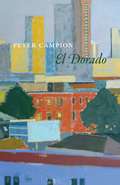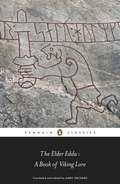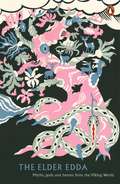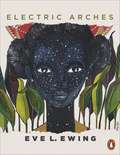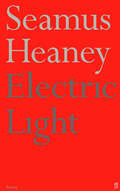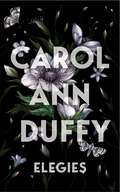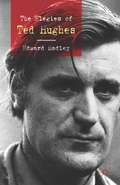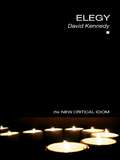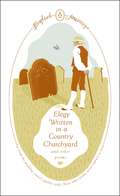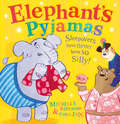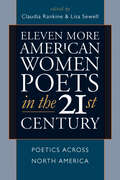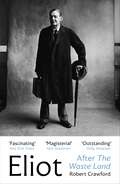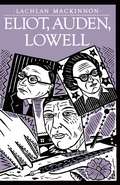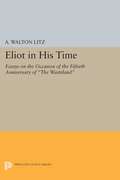- Table View
- List View
Einführung in die Gedichtanalyse (Sammlung Metzler)
by Dieter BurdorfDer Autor stellt die Methoden des literaturwissenschaftlichen Umgangs mit Gedichten vor und veranschaulicht sie an zahlreichen Beispielen aus der deutschsprachigen Lyrik vom Barock bis zur Gegenwart. Schwierige Gebiete wie Metrik, Strophik und Metaphorik werden ohne komplizierten Begriffsapparat dargestellt. Es wird gezeigt, wie man mit der Vieldeutigkeit von Gedichten umgehen kann, welche Rolle Personen, Zeit und Raum in der Lyrik spielen und wie man die Entwicklungsstufen und die verschiedenen Fassungen eines Gedichts für die Analyse fruchtbar machen kann.
The Ekphrastic Encounter in Contemporary British Poetry and Elsewhere
by David KennedyExamining a wide range of ekphrastic poems, David Kennedy argues that contemporary British poets writing out of both mainstream and avant-garde traditions challenge established critical models of ekphrasis with work that is more complex than representational or counter-representational responses to paintings in museums and galleries. Even when the poem appears to be straightforwardly representational, it is often selectively so, producing a 'virtual' work that doesn't exist in actuality. Poets such as Kelvin Corcoran, Peter Hughes, and Gillian Clarke, Kennedy suggests, relish the ekphrastic encounter as one in which word and image become mutually destabilizing. Similarly, other poets engage with the source artwork as a performance that participates in the ethical realm. Showing that the ethical turn in ekphrastic poetry is often powerfully gendered, Kennedy also surveys a range of ekphrastic poets from the Renaissance and nineteenth century to trace a tradition of female ekphrastic poetry that includes Pauline Stainer and Frances Presley. Kennedy concludes with a critique of ekphrastic exercises in creative writing teaching, proposing that ekphrastic writing that takes greater account of performance spectatorship may offer more fruitful models for the classroom than the narrativizing of images.
The Ekphrastic Encounter in Contemporary British Poetry and Elsewhere
by David KennedyExamining a wide range of ekphrastic poems, David Kennedy argues that contemporary British poets writing out of both mainstream and avant-garde traditions challenge established critical models of ekphrasis with work that is more complex than representational or counter-representational responses to paintings in museums and galleries. Even when the poem appears to be straightforwardly representational, it is often selectively so, producing a 'virtual' work that doesn't exist in actuality. Poets such as Kelvin Corcoran, Peter Hughes, and Gillian Clarke, Kennedy suggests, relish the ekphrastic encounter as one in which word and image become mutually destabilizing. Similarly, other poets engage with the source artwork as a performance that participates in the ethical realm. Showing that the ethical turn in ekphrastic poetry is often powerfully gendered, Kennedy also surveys a range of ekphrastic poets from the Renaissance and nineteenth century to trace a tradition of female ekphrastic poetry that includes Pauline Stainer and Frances Presley. Kennedy concludes with a critique of ekphrastic exercises in creative writing teaching, proposing that ekphrastic writing that takes greater account of performance spectatorship may offer more fruitful models for the classroom than the narrativizing of images.
Ekphrastic Medieval Visions: A New Discussion in Interarts Theory (The New Middle Ages)
by C. BarbettiExplores the transformative power of ekphrasis in high and late medieval dream visions and mystical visions. Demonstrates that medieval ekphrases reveal ekphrasis as a process rather than a genre and shows how it works with cultural memory to transform, shift, and revise composition.
El Dorado (Phoenix Poets)
by Peter CampionIn El Dorado, Peter Campion explores what it feels like to live in America right now, at the beginning of the twenty-first century. Splicing cell-phone chatter with translations of ancient poems, jump-cutting from traditional to invented forms, and turning his high-res lens on everything from box stores to trout streams to airport lounges, Campion renders both personal and collective experience with capacious and subtle skill.
El Dorado (Phoenix Poets)
by Peter CampionIn El Dorado, Peter Campion explores what it feels like to live in America right now, at the beginning of the twenty-first century. Splicing cell-phone chatter with translations of ancient poems, jump-cutting from traditional to invented forms, and turning his high-res lens on everything from box stores to trout streams to airport lounges, Campion renders both personal and collective experience with capacious and subtle skill.
El Dorado (Phoenix Poets)
by Peter CampionIn El Dorado, Peter Campion explores what it feels like to live in America right now, at the beginning of the twenty-first century. Splicing cell-phone chatter with translations of ancient poems, jump-cutting from traditional to invented forms, and turning his high-res lens on everything from box stores to trout streams to airport lounges, Campion renders both personal and collective experience with capacious and subtle skill.
El Dorado (Phoenix Poets)
by Peter CampionIn El Dorado, Peter Campion explores what it feels like to live in America right now, at the beginning of the twenty-first century. Splicing cell-phone chatter with translations of ancient poems, jump-cutting from traditional to invented forms, and turning his high-res lens on everything from box stores to trout streams to airport lounges, Campion renders both personal and collective experience with capacious and subtle skill.
The Elder Edda: A Book of Viking Lore
by Andy OrchardCompiled by an unknown scribe in Iceland around 1270, and based on sources dating back centuries earlier, these mythological and heroic poems tell of gods and mortals from an ancient era: the giant-slaying Thor, the doomed Völsung family, the Hel-ride of Brynhild and the cruelty of Atli the Hun. Eclectic, incomplete and fragmented, these verses nevertheless retain their stark beauty and their power to enthrall, opening a window on to the thoughts, beliefs and hopes of the Vikings and their world.
The Elder Edda: A Book Of Viking Lore (Legends From The Ancient North Ser.)
by Andy OrchardPart of a new series Legends from the Ancient North, The Elder Edda is one of the classic books that influenced JRR Tolkien's The Hobbit and The Lord of the Rings'So the company of men led a careless life,All was well with them: until One beganTo encompass evil, an enemy from hell.Grendel they called this cruel spirit...'J.R.R. Tolkien spent much of his life studying, translating and teaching the great epic stories of northern Europe, filled with heroes, dragons, trolls, dwarves and magic. He was hugely influential for his advocacy of Beowulf as a great work of literature and, even if he had never written The Hobbit and The Lord of the Rings, would be recognised today as a significant figure in the rediscovery of these extraordinary tales.Legends from the Ancient North brings together from Penguin Classics five of the key works behind Tolkien's fiction.They are startling, brutal, strange pieces of writing, with an elemental power brilliantly preserved in these translations.They plunge the reader into a world of treachery, quests, chivalry, trials of strength.They are the most ancient narratives that exist from northern Europe and bring us as near as we will ever get to the origins of the magical landscape of Middle-earth (Midgard) which Tolkien remade in the 20th century.
Electric Arches
by Eve EwingBlending stark realism with the surreal and fantastic, Eve L. Ewing's narrative takes us from the streets of Chicago to an unspecified future, deftly navigating the boundaries of space, time, and reality. Ewing imagines familiar figures in magical circumstances, and identifies everyday objects - hair moisturizer, a spiral notebook - as precious icons.Her visual art is spare, playful and poignant: a cereal-box decoder ring that allows the wearer to understand what Black girls are saying; a teacher's angry, subversive message scrawled on the chalkboard. Electric Arches invites fresh conversations about race, gender, the city, identity and the joy and pain of growing up.
Electric Light: Poems (Colección Visor De Poesía Ser. #Vol. 503)
by Seamus HeaneyElectric Light travels widely in time and space, visiting the sites of the classical world, revisiting the poet's childhood: rural electrification and the light of ancient evenings are reconciled within the orbit of a single lifetime. This is a book about origins (not least the origins of words) and oracles: the places where things start from, the ground of understanding - whether in Arcadia or Anahorish, the sanctuary at Epidaurus or the Bann valley in County Derry.Electric Light ranges from short takes ('glosses') to conversation poems whose cunning passagework gives rein to 'the must and drift of talk'; other poems are arranged in sections, their separate cargoes docked alongside each other to reveal a hidden and curative connection. The presocratic wisdom that everything flows is held in tension with the fixities of remembrance: elegising friends and fellow poets, naming 'the real names' of contemporaries behind the Shakespearean roles they played at school. These gifts of recollection renew the poet's calling to assign to things their proper names. The resulting poems are full of delicately prescriptive tonalities, where Heaney can be heard extending his word-hoard and rollcall in this, his eleventh collection.
Elegies
by Professor Carol Ann Duffy DBEOne of the English language’s best-loved living poets arrays before us here, in chronological order, her favourites among her poems on death, drawing on work written over four decades, and adds to her selection one wholly new poem. It makes for a sequence that is warm, vibrant, alive.
Elegies: With parallel Latin text (Oxford World's Classics)
by Tibullus'Delia, when flames engulf my bier you'll weep for me, and then you'll mix your kisses with sad tears.' Tibullus (?55-18 BC) was one of a group of poets known as the Latin elegists, whose number included Ovid and Propertius. Living in the age of Augustus, his poems reflect Augustan ideals, but they are above all notable for their emphasis on the personal, and for their subject-matter, love. Tibullus' elegies are addressed to two different mistresses, Delia and Nemesis, and a boy, Marathus. His pious and idealistic love for Delia is replaced by a more tortured affair with the cruel Nemesis, and the poet's elegies to Marathus give a broader perspective to his treatment of the subject. Anguish and betrayal characterize Tibullus' depiction of love's changing fortunes, in poetry that is passionate, vivid, and sometimes haunting. In this parallel text edition, A. M. Juster's eloquent translations are accompanied by an introduction and notes from Robert Maltby which discuss Tibullus' work in its literary and historical context. Together they demonstrate the achievements of this fine Roman poet. ABOUT THE SERIES: For over 100 years Oxford World's Classics has made available the widest range of literature from around the globe. Each affordable volume reflects Oxford's commitment to scholarship, providing the most accurate text plus a wealth of other valuable features, including expert introductions by leading authorities, helpful notes to clarify the text, up-to-date bibliographies for further study, and much more.
The Elegies of Ted Hughes
by E. HadleyThe elegiac aspect of Ted Hughes' poetry has been frequently overlooked, an oversight which this book sets out to rectify. Encompassing a broad range of themes, from the decline of nature and local industry to the national grief caused by the First World War, this book is a comprehensive addition to the study of Hughes' poetry.
Elegy: Poetry, Elegy, Walking, Spirit (The New Critical Idiom)
by David KennedyGrief and mourning are generally considered to be private, yet universal instincts. But in a media age of televised funerals and visible bereavement, elegies are increasingly significant and open to public scrutiny. Providing an overview of the history of the term and the different ways in which it is used, David Kennedy: outlines the origins of elegy, and the characteristics of the genre examines the psychology and cultural background underlying works of mourning explores how the modern elegy has evolved, and how it differs from ‘canonical elegy’, also looking at female elegists and feminist readings considers the elegy in the light of writing by theorists such as Jacques Derrida and Catherine Waldby looks at the elegy in contemporary writing, and particularly at how it has emerged and been adapted as a response to terrorist attacks such as 9/11. Emphasising and explaining the significance of elegy today, this illuminating guide to an emotive literary genre will be of interest to students of literature, media and culture.
Elegy (The New Critical Idiom)
by David KennedyGrief and mourning are generally considered to be private, yet universal instincts. But in a media age of televised funerals and visible bereavement, elegies are increasingly significant and open to public scrutiny. Providing an overview of the history of the term and the different ways in which it is used, David Kennedy: outlines the origins of elegy, and the characteristics of the genre examines the psychology and cultural background underlying works of mourning explores how the modern elegy has evolved, and how it differs from ‘canonical elegy’, also looking at female elegists and feminist readings considers the elegy in the light of writing by theorists such as Jacques Derrida and Catherine Waldby looks at the elegy in contemporary writing, and particularly at how it has emerged and been adapted as a response to terrorist attacks such as 9/11. Emphasising and explaining the significance of elegy today, this illuminating guide to an emotive literary genre will be of interest to students of literature, media and culture.
Elegy Written in a Country Churchyard and Other Poems
by Thomas GrayThe English countryside has inspired some of the most exquisite and well-loved poetry ever composed in the language. This selection of verse includes, among others, Thomas Gray's reflective and moving meditation on mortality, 'Elegy Written in a Country Church Yard', the soaring beauty of Wordsworth's lines on Tintern Abbey and Keats's ode to Autumn, the deceptively simple words of Emily Brontë and the personal and evocative verse of Thomas Hardy, bringing together the greatest riches of English poetry.Generations of inhabitants have helped shape the English countryside - but it has profoundly shaped us too.It has provoked a huge variety of responses from artists, writers, musicians and people who live and work on the land - as well as those who are travelling through it.English Journeys celebrates this long tradition with a series of twenty books on all aspects of the countryside, from stargazey pie and country churches, to man's relationship with nature and songs celebrating the patterns of the countryside (as well as ghosts and love-struck soldiers).
Elephant’s Pyjamas
by Michelle RobinsonSleepovers have never been so silly! A hilarious animal story from award winning children’s author, Michelle Robinson and debut picture book illustrator, Emily Fox.
Eleven More American Women Poets in the 21st Century: Poetics Across North America (American Poets in the 21st Century)
by Claudia Rankine Lisa SewellEleven More American Women Poets in the 21st Century is an exciting sequel to its predecessors in the American Poets in the 21st Century series. Like the earlier anthologies, this volume includes generous selections of poetry by some of the best poets of our time as well as illuminating poetics statements and incisive essays on their work. This unique organization makes these books invaluable teaching tools. Broadening the lens through which we look at contemporary poetry, this new volume extends its geographical net by including Caribbean and Canadian poets. Representing three generations of women writers, among the insightful pieces included in this volume are essays by Karla Kelsey on Mary Jo Bang's modes of artifice, Christine Hume on Carla Harryman's kinds of listening, Dawn Lundy Martin on M. NourbeSe Phillip (for whom "english / is a foreign anguish"), and Sina Queyras on Lisa Robertson's confoundingly beautiful surfaces. A companion web site will present audio of each poet's work.
Eliot After The Waste Land (Eliot Biographies #2)
by Robert CrawfordThe second volume of Robert Crawford's magisterial biography of the revolutionary modernist, visionary poet and troubled man, drawing on extensive new sources.In this compelling and meticulous portrait of the twentieth century's most important poet, Robert Crawford completes the story he began in Young Eliot. Drawing on extensive new sources and letters, this is the first full-scale biography to make use of Eliot's most significant surviving correspondence, including the archive of letters (unsealed for the first time in 2020) detailing his decades-long love affair with Emily Hale.This long-awaited second volume, Eliot After 'The Waste Land', tells the story of the mature Eliot, his years as a world-renowned writer and intellectual, and his troubled interior life.From his time as an exhausted bank employee after the publication of The Waste Land, through the emotional turmoil of the 1920s and 1930s, and his years as a firewatcher in bombed wartime London, Crawford reveals the public and personal experiences that helped generate some of Eliot's masterpieces.He explores the poet's religious conversion, his editorship at Faber and Faber, his separation from Vivien Haigh-Wood and happy second marriage to Valerie Fletcher, and his great work Four Quartets.Robert Crawford presents this complex and remarkable man not as a literary monument but as a human being: as a husband, lover and widower, as a banker, editor, playwright and publisher, but most of all as an epoch-shaping poet struggling to make art among personal disasters.
Eliot in His Time: Essays on the Occasion of the Fiftieth Anniversary of "The Wasteland"
by A. Walton LitzThe essays in this new collection, all by outstanding experts in the field of modern literature, provide a different and more complex sense of Eliot's place in literary history. The eight essays are: "The Waste Land Fifty Years After," by A. Walton Litz; "The Urban Apocalypse," by Hugh Kenner; "The First Waste Land:' by Richard Ellmann;" The Waste Land: Paris 1922," by Helen Gardner; "New Modes of Characterization in The Waste Land," by Robert Langbaum; "Precipitating Eliot," by Robert M. Adams; "Fear in the Way: The Design of Eliot's Drama," by Michael Goldman; and "Anglican Eliot," by Donald Davie.Originally published in 1973.The Princeton Legacy Library uses the latest print-on-demand technology to again make available previously out-of-print books from the distinguished backlist of Princeton University Press. These editions preserve the original texts of these important books while presenting them in durable paperback and hardcover editions. The goal of the Princeton Legacy Library is to vastly increase access to the rich scholarly heritage found in the thousands of books published by Princeton University Press since its founding in 1905.
